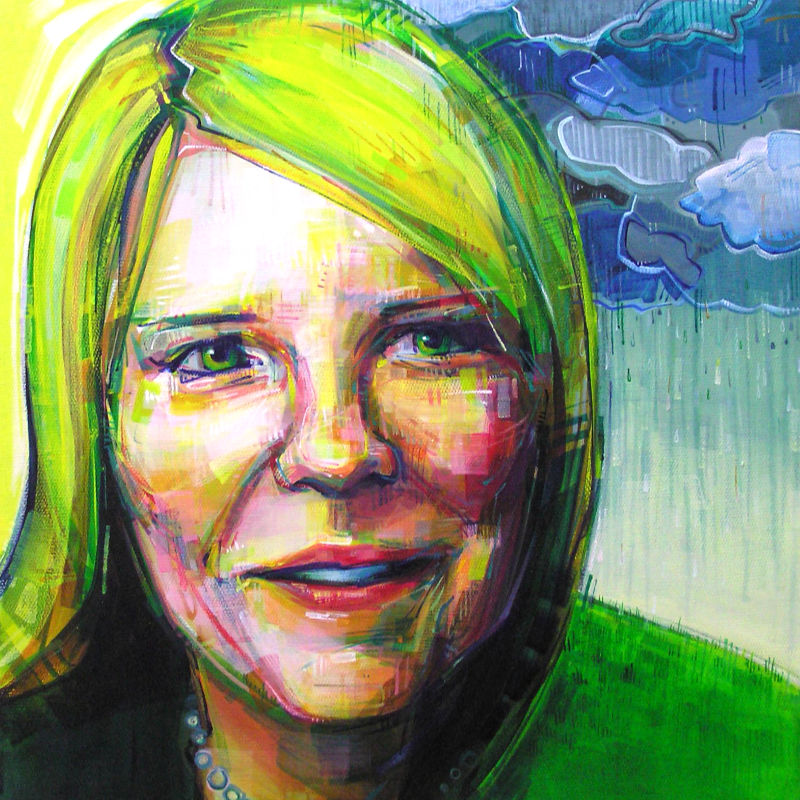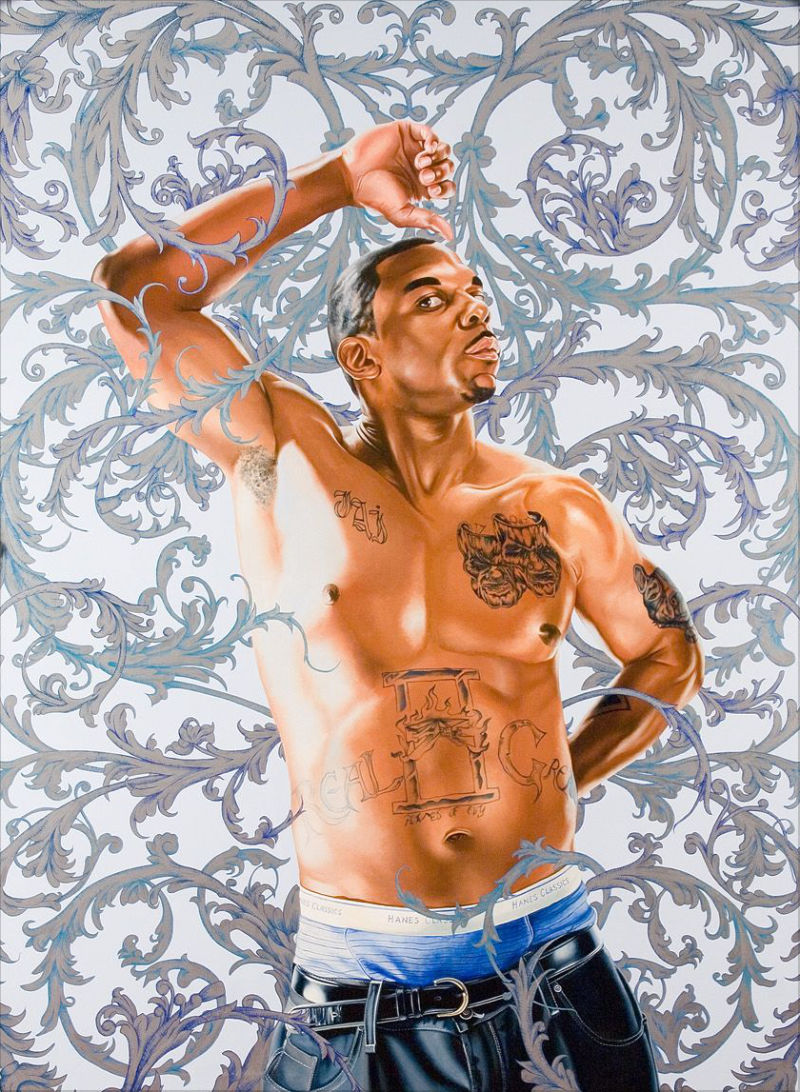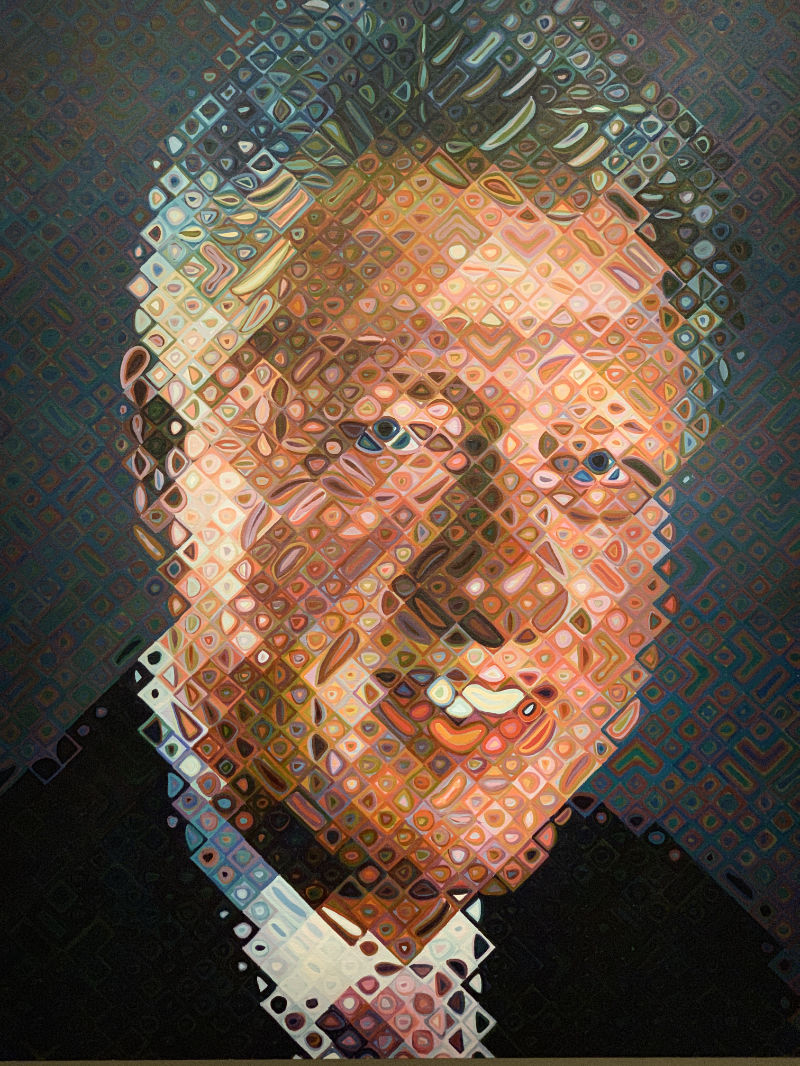Blog / 2008 / This, for Example, Is a Real Person.
March 4, 2008

After: Wedding
2007
acrylic on bird’s eye piqué
30 x 30 inches
(Part of Swollen, “before” and “after” portraits of women in transition.)
I can’t count the number of times that someone on the business end of art has told me that the one thing that I love most about my work is precisely what makes it unsalable in a commercial gallery setting:
It just looks too much like a real person.
Then, as if I haven’t heard it a million times before, they add:
No one is going to want someone they don’t know hanging on their wall, and that severely limits the potential buyers for the work.
So what about Kehinde Wiley’s paintings? Or Chuck Close’s? These two so-called “portrait painters” have no problem selling their work to people who don’t know their subjects. It must be more than their Yale MFAs and my lack thereof that causes this gap between my more modest marketability and their runaway success. I have a little theory about just what these artists’ work has on mine, and it’s deceptively simple.
These two “portrait painters” aren’t actually painting portraits.
Close and Wiley are making paintings from models. They’re making figurative work. Conversely, the people portrayed in my work are not just happenings that inspire my paintings: they’re the very reasons for the paintings. Unlike my would-be peers, I actually care about the people in my work and, more importantly, I show it.

The work that Wiley is most famous for are paintings of African American men between the ages of eighteen and thirty or so. The models are selected based on a certain “look” by the Kehinde Wiley team which then proceeds to dress the model to further push that certain je-ne-sais-quoi. Finally, the model is asked to pose for a camera like some dead white man from a Renaissance painting, and Wiley paints from this photograph.*
The concept behind the work is stunning. I love it. But I still wish Wiley would bother to meet his models if he’s going to label his works “portraits.”
Close’s faults, as I see them, are similar. His trusted formula—centered and mostly neutral faces—drains the personality out of all of his models and a quick search online of images by him proves as much.
Close’s work is driven by questions of color and composition. He chooses photos to paint from based on which image calls out to him for formal reasons, regardless of whom it happens to be.** It’s a decision which doesn’t acknowledge the humanity of the model in the least. While technically beautiful, Close’s work manages to make a human face so neutral that it might as well be a particularly pleasing wallpaper pattern.

As further proof of his lack of interest in his model, his portrait of President Bill Clinton hardly deviates from his formula. Even for such an important and potentially interesting model, Close won’t modify what he does. The only two concessions made, so far as I can tell, are poorly chosen. In his painting, Close allows the President to smile and also to angle his shoulders and head out of the straight-on centered pose which is prevalent in the artist’s work. In other words, Close ended up Close-ifying the average press head shot of the President, showing us nothing new of this curious and enigmatic world leader.
None of which is to say that I don’t like Wiley’s or Close’s work.*** I admire their oeuvres, but I object to them being called “portrait painters.”
Which leaves just one question: if I’m so sure that the respect I show my subjects is what is holding my work back, why don’t I reform my ways?
I can’t. I refuse. I will care about the people I paint, even if the finished painting is only really interesting to me, the subject, and the subject’s circle.
Most artists can’t be certain that they’re touching anyone with their work (and a lot of them aren’t even trying!). I’m lucky. I know that each one of my paintings has a fascinated audience of at least one. A portrait is, at a minimum, a personal revolution. And I happen to think that there’s something to be said for that!
* Information taken from the lecture that Wiley gave at the Portland Art Museum in August 2007.
** Information taken from the Men’s Vogue interview “Chuck and Bill” from 2007.
*** I like Wiley’s work a lot, but I think he should choose his team a little better. When I saw some of his work in person, the background elements (which his assistants execute) were badly painted. It led me to think that Wiley’s team didn’t have enough paint to cover the pencil tracing of the floral curlicues! But, the work looks good in reproduction, which is, I think, its purpose. And my only regret for Close’s work is one which doesn’t conflict with his ideas at all. Techno-types have made a filter of his style now, allowing the user to make a Close-like mosaic out of any image. Because there’s nothing else to his painting but technical skill—because he doesn’t care about his models—the filter does a rather good job at Close-ifying a photo, though, of course, without the hand-painted grandeur of Close’s colossal works.
Maybe this post made you think of something you want to share with me? Or perhaps you have a question about my art? I’d love to hear from you!
To receive an email every time I publish a new article or video, sign up for my special mailing list.
If you enjoyed this post, Ko-fi allows you to donate. Every dollar you give is worth a bajillion to me!



